新起点英语二年级下册Unit 3《Seasons》word教案
- 格式:doc
- 大小:69.00 KB
- 文档页数:9
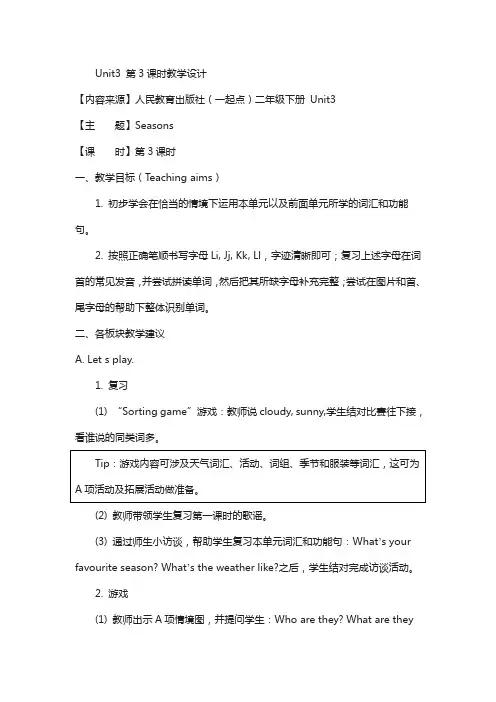
Unit3 第3课时教学设计【内容来源】人民教育出版社(一起点)二年级下册Unit3【主题】Seasons【课时】第3课时一、教学目标(Teaching aims)1. 初步学会在恰当的情境下运用本单元以及前面单元所学的词汇和功能句。
2. 按照正确笔顺书写字母Li, Jj, Kk, Ll,字迹清晰即可;复习上述字母在词首的常见发音,并尝试拼读单词,然后把其所缺字母补充完整;尝试在图片和首、尾字母的帮助下整体识别单词。
二、各板块教学建议A. Let s play.1. 复习(1) “Sorting game”游戏:教师说cloudy, sunny,学生结对比赛往下接,看谁说的同类词多。
(2) 教师带领学生复习第一课时的歌谣。
(3) 通过师生小访谈,帮助学生复习本单元词汇和功能句:What’s your favourite season? What’s the weather like?之后,学生结对完成访谈活动。
2. 游戏(1) 教师出示A项情境图,并提问学生:Who are they? What are they doing?How can they play the game?(2) 让学生听对话录音,关注录音中人物的语言,了解游戏方式。
(3) 教师准备好卡片,然后请一名学生上讲台前与教师一起再次进行示范,以帮助学生再次了解游戏语言和过程。
(4) 学生结对展开游戏。
(5) 男女生比赛:请一名学生上讲台前,其他学生集体向他/她提问:What’s your favourite season? What’s the weather like?站在讲台前回答问题的学生和最快猜到答案的学生均可以按男女生分组加分。
B. Let’s write.1. 复习字母(1) 教师快速闪现字母卡片,帮助学生复习字母。
(2) 教师组织学生开展“大小写字母找朋友”的活动。
2. 学习书写字母(1) 学生观察字母的占格。
(2) 学生观察字母的笔顺。
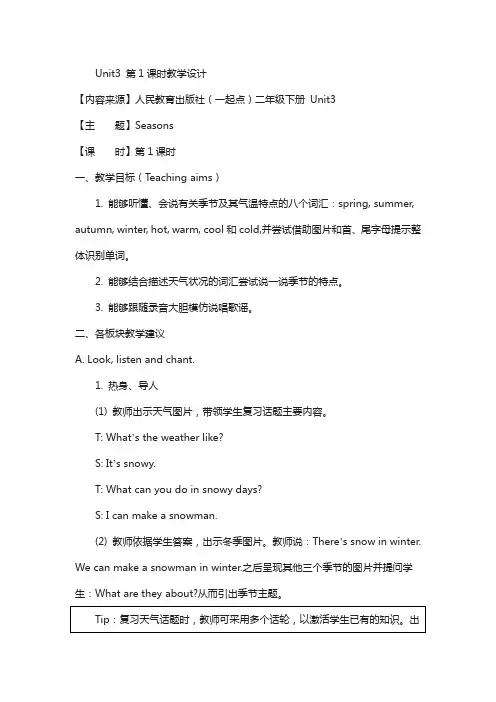
Unit3 第1课时教学设计【内容来源】人民教育出版社(一起点)二年级下册Unit3【主题】Seasons【课时】第1课时一、教学目标(Teaching aims)1. 能够听懂、会说有关季节及其气温特点的八个词汇:spring, summer, autumn, winter, hot, warm, cool和cold,并尝试借助图片和首、尾字母提示整体识别单词。
2. 能够结合描述天气状况的词汇尝试说一说季节的特点。
3. 能够跟随录音大胆模仿说唱歌谣。
二、各板块教学建议A. Look, listen and chant.1. 热身、导人(1) 教师出示天气图片,带领学生复习话题主要内容。
T: What’s the weather like?S: It’s snowy.T: What can you do in snowy days?S: I can make a snowman.(2) 教师依据学生答案,出示冬季图片。
教师说:There’s snow in winter. We can make a snowman in winter.之后呈现其他三个季节的图片并提问学生:What are they about?从而引出季节主题。
2. 呈现新的学习内容(1) 教师播放歌谣录音,让学生整体感知语言。
(2) 教师再次播放歌谣录音,让学生感知季节词汇。
教师跟随录音用手指相应的季节图片,引导学生关注,帮助他们初步建立词汇的音和义之间的联系。
(3) 教师再次播放歌谣录音,让学生感知气温特点的词汇。
接着,教师呈现温度计图片和四个表示气温特点的词汇。
之后,教师可将warm移至spring的旁边,然后说:It’s warm. Spring is warm.然后请学生结合自己的生活经验,尝试将其他三个词放在相应的季节图片旁。
(4) 教师再次播放歌谣录音,验证学生的答案。
3. 词汇学习和操练(1) 学生听新词汇的录音:第一遍认真听,第二遍跟读。
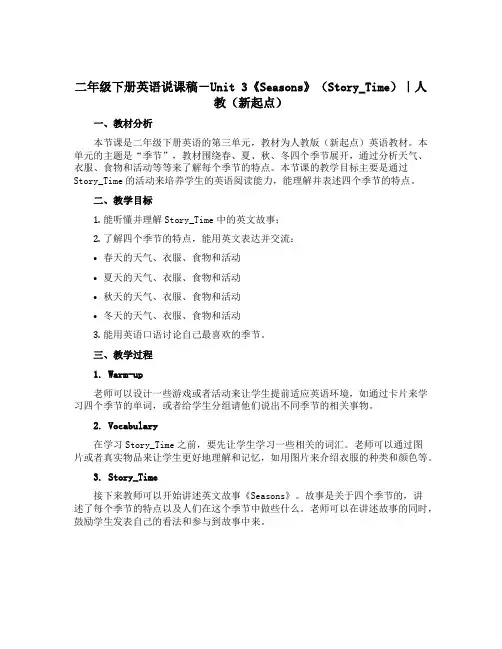
二年级下册英语说课稿-Unit 3《Seasons》(Story_Time)|人教(新起点)一、教材分析本节课是二年级下册英语的第三单元,教材为人教版(新起点)英语教材。
本单元的主题是“季节”,教材围绕春、夏、秋、冬四个季节展开,通过分析天气、衣服、食物和活动等等来了解每个季节的特点。
本节课的教学目标主要是通过Story_Time的活动来培养学生的英语阅读能力,能理解并表述四个季节的特点。
二、教学目标1.能听懂并理解Story_Time中的英文故事;2.了解四个季节的特点,能用英文表达并交流:•春天的天气、衣服、食物和活动•夏天的天气、衣服、食物和活动•秋天的天气、衣服、食物和活动•冬天的天气、衣服、食物和活动3.能用英语口语讨论自己最喜欢的季节。
三、教学过程1. Warm-up老师可以设计一些游戏或者活动来让学生提前适应英语环境,如通过卡片来学习四个季节的单词,或者给学生分组请他们说出不同季节的相关事物。
2. Vocabulary在学习Story_Time之前,要先让学生学习一些相关的词汇。
老师可以通过图片或者真实物品来让学生更好地理解和记忆,如用图片来介绍衣服的种类和颜色等。
3. Story_Time接下来教师可以开始讲述英文故事《Seasons》。
故事是关于四个季节的,讲述了每个季节的特点以及人们在这个季节中做些什么。
老师可以在讲述故事的同时,鼓励学生发表自己的看法和参与到故事中来。
4. Discussion讲完Story_Time后,老师可以组织学生进行小组讨论,让学生分享他们最喜欢的季节和他们最喜欢的季节活动,从而让学生更加深入地了解四个季节的特点和各个季节的不同之处。
5. Homework针对本课的教学内容,可以让学生回家记录自己最喜欢的季节,并简单描述一下这个季节的特点。
老师也可以用一些小游戏来帮助学生复习所学内容,如Match_up、Fill_in_the_blank等等。
四、教学方式和方法1.读故事2.活动3.建议小组讨论4.激励学生思考,启发思路5.根据学生的喜好和兴趣选用不同的教学方法五、板书设计季节 - 各自特点春天天气衣服食物活动夏天…秋天…冬天…六、教学反思本课是介绍四个季节的特点,旨在帮助学生更好地了解每个季节的变化和特点,让学生学会用英文表达自己的想法。
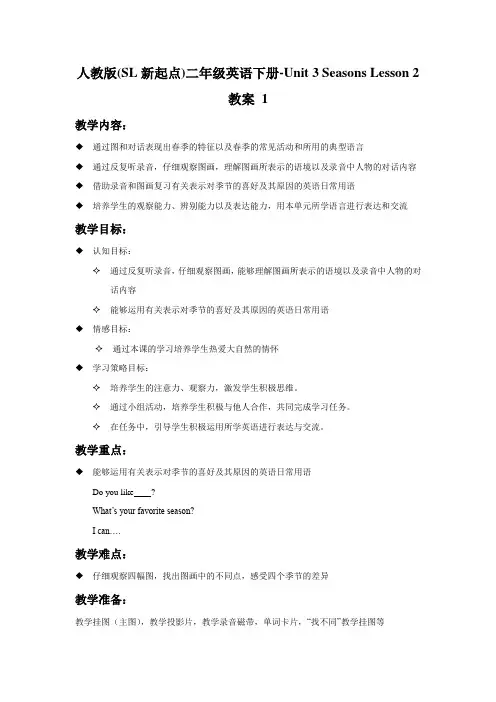
人教版(SL新起点)二年级英语下册-Unit 3 Seasons Lesson 2教案 1教学内容:◆通过图和对话表现出春季的特征以及春季的常见活动和所用的典型语言◆通过反复听录音,仔细观察图画,理解图画所表示的语境以及录音中人物的对话内容◆借助录音和图画复习有关表示对季节的喜好及其原因的英语日常用语◆培养学生的观察能力、辨别能力以及表达能力,用本单元所学语言进行表达和交流教学目标:◆认知目标:✧通过反复听录音,仔细观察图画,能够理解图画所表示的语境以及录音中人物的对话内容✧能够运用有关表示对季节的喜好及其原因的英语日常用语◆情感目标:✧通过本课的学习培养学生热爱大自然的情怀◆学习策略目标:✧培养学生的注意力、观察力,激发学生积极思维。
✧通过小组活动,培养学生积极与他人合作,共同完成学习任务。
✧在任务中,引导学生积极运用所学英语进行表达与交流。
教学重点:◆能够运用有关表示对季节的喜好及其原因的英语日常用语Do you like ?What’s your favorite season?I can….教学难点:◆仔细观察四幅图,找出图画中的不同点,感受四个季节的差异教学准备:教学挂图(主图),教学投影片,教学录音磁带,单词卡片,“找不同”教学挂图等教学步骤:1. warming up (热身活动)2. reviewing and leading in (复习并导入新课)✧Review the words1)Read the words together2)Activity: What’s missing?3)Guessing game✧Review the expression1)Guessing the season: make action——guess——review the expression2)Ask and answerT: Do you like spring? Ss: Yes.T: Why? Ss: It’s.(为新课作准备铺垫)3. learning(学习新课)✧A整体呈现(观察挂图,听录音)✧设置问题T: Who are they? (观察)What can you see in the picture?T: What can you hear? (听第二遍录音前提问)✧Learn the text1) 1听录音,跟读课文2 T: What color is the grass\hill\tree ? (听到look, the grass is green)T: What else can you do in spring? Ss: Fly kites…3Ask 2 students to read the dialogue2) 1听录音,跟读课文2 What’s your favorite season?讲解, 询问同学,小组间练习3Ask 2 students to read the dialogue3)1听录音,跟读课文2 Ask 2 students to read the dialogue✧ B1)观察What can you see?扩展新单词willow,lotus,leaves,pavilion2)Ask and answerT: What’s the color of the tree\hill\grass?(review the colors)3)先让学生找出不同(独立完成)——pair work——sh ow some students’ jobs 4)T: Are they the same? Ss: No, they’re different.(利用实物,理解They are the same. They’re different)4. practicing (操练)✧Make a dialogue and perform(教师帮助学生创设情境,进行对话、表演,尽量多用新学词汇与句型)✧拓展summer fall winter 季节中能够运用的对话✧pair work——show5. summary (小结)✧复习了前两课所学的词汇与句型✧在一定情境下会使用本单元有关季节的交际用语来进行对话6. homework (家庭作业)✧Listen to the tape and repeat.✧Tell your parents the differences between the pictures.。
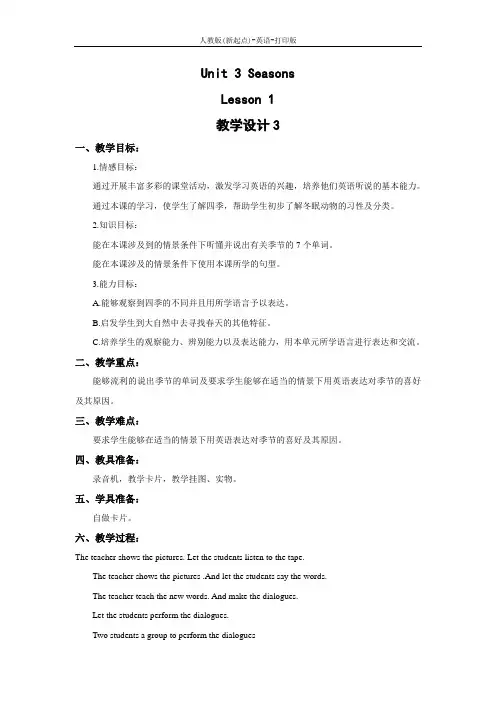
Unit 3 SeasonsLesson 1教学设计3一、教学目标:1.情感目标:通过开展丰富多彩的课堂活动,激发学习英语的兴趣,培养他们英语听说的基本能力。
通过本课的学习,使学生了解四季,帮助学生初步了解冬眠动物的习性及分类。
2.知识目标:能在本课涉及到的情景条件下听懂并说出有关季节的7个单词。
能在本课涉及的情景条件下使用本课所学的句型。
3.能力目标:A.能够观察到四季的不同并且用所学语言予以表达。
B.启发学生到大自然中去寻找春天的其他特征。
C.培养学生的观察能力、辨别能力以及表达能力,用本单元所学语言进行表达和交流。
二、教学重点:能够流利的说出季节的单词及要求学生能够在适当的情景下用英语表达对季节的喜好及其原因。
三、教学难点:要求学生能够在适当的情景下用英语表达对季节的喜好及其原因。
四、教具准备:录音机,教学卡片,教学挂图、实物。
五、学具准备:自做卡片。
六、教学过程:The teacher shows the pictures. Let the students listen to the tape.The teacher shows the pictures .And let the students say the words.The teacher teach the new words. And make the dialogues.Let the students perform the dialogues.Two students a group to perform the dialogues2. Play the games and help the students to grasp the words.A. The teacher reads the words.B. Let the students show the pictures of the new words.C. The teacher let the students do the actions.D. Pair work.E. Use the pictures to play the games.3.Dialogues:Angel: It’s spring! It’s spring!Yaoyao: Let’s plant trees .Joy: What’s your favorite season?Lily: Spring.Joy: Why?Lily: It’s beautiful! I can wear my red sweater.Binbin: Do you like spring?Bill: Yes, I like it very much.Binbin: Why?Bill: I can fly a kite in spring.Andy: Look, the grass is green.Lucky: Wow!Listen to the tape .And then make dialogues4. Group work.Listening.Song.5. Homework:Copy the words.Read the text.。
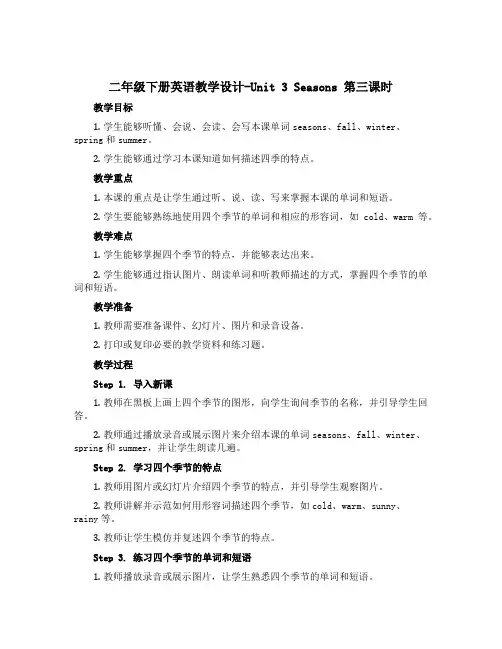
二年级下册英语教学设计-Unit 3 Seasons 第三课时教学目标
1.学生能够听懂、会说、会读、会写本课单词seasons、fall、winter、
spring和summer。
2.学生能够通过学习本课知道如何描述四季的特点。
教学重点
1.本课的重点是让学生通过听、说、读、写来掌握本课的单词和短语。
2.学生要能够熟练地使用四个季节的单词和相应的形容词,如cold、warm等。
教学难点
1.学生能够掌握四个季节的特点,并能够表达出来。
2.学生能够通过指认图片、朗读单词和听教师描述的方式,掌握四个季节的单词和短语。
教学准备
1.教师需要准备课件、幻灯片、图片和录音设备。
2.打印或复印必要的教学资料和练习题。
教学过程
Step 1. 导入新课
1.教师在黑板上画上四个季节的图形,向学生询问季节的名称,并引导学生回答。
2.教师通过播放录音或展示图片来介绍本课的单词seasons、fall、winter、spring和summer,并让学生朗读几遍。
Step 2. 学习四个季节的特点
1.教师用图片或幻灯片介绍四个季节的特点,并引导学生观察图片。
2.教师讲解并示范如何用形容词描述四个季节,如cold、warm、sunny、
rainy等。
3.教师让学生模仿并复述四个季节的特点。
Step 3. 练习四个季节的单词和短语
1.教师播放录音或展示图片,让学生熟悉四个季节的单词和短语。
2.教师让学生跟读词语并练习发音。
Step 4. 听力训练
1.教师播放录音,让学生听数次,并回答问题,如。
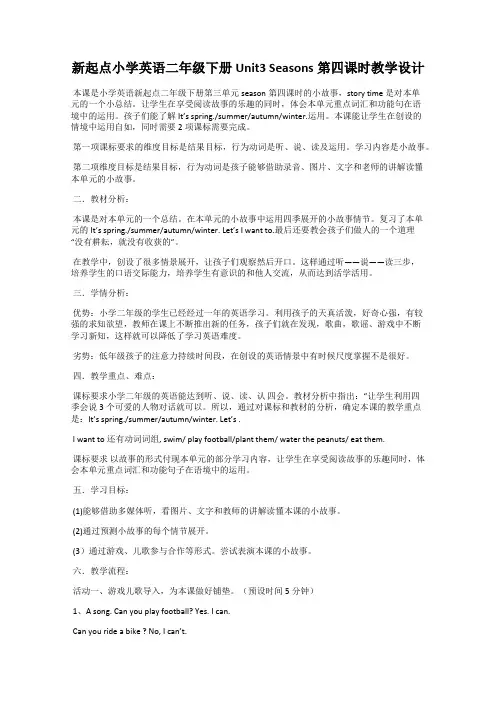
新起点小学英语二年级下册Unit3 Seasons第四课时教学设计本课是小学英语新起点二年级下册第三单元season第四课时的小故事,story time 是对本单元的一个小总结。
让学生在享受阅读故事的乐趣的同时,体会本单元重点词汇和功能句在语境中的运用。
孩子们能了解It’s spring./summer/autumn/winter.运用。
本课能让学生在创设的情境中运用自如,同时需要2项课标需要完成。
第一项课标要求的维度目标是结果目标,行为动词是听、说、读及运用。
学习内容是小故事。
第二项维度目标是结果目标,行为动词是孩子能够借助录音、图片、文字和老师的讲解读懂本单元的小故事。
二.教材分析:本课是对本单元的一个总结。
在本单元的小故事中运用四季展开的小故事情节。
复习了本单元的It’s spring./summer/autumn/winter. Let’s I want to.最后还要教会孩子们做人的一个道理“没有耕耘,就没有收获的”。
在教学中,创设了很多情景展开,让孩子们观察然后开口。
这样通过听——说——读三步,培养学生的口语交际能力,培养学生有意识的和他人交流,从而达到活学活用。
三.学情分析:优势:小学二年级的学生已经经过一年的英语学习。
利用孩子的天真活泼,好奇心强,有较强的求知欲望,教师在课上不断推出新的任务,孩子们就在发现,歌曲,歌谣、游戏中不断学习新知,这样就可以降低了学习英语难度。
劣势:低年级孩子的注意力持续时间段,在创设的英语情景中有时候尺度掌握不是很好。
四.教学重点、难点:课标要求小学二年级的英语能达到听、说、读、认四会。
教材分析中指出:“让学生利用四季会说3个可爱的人物对话就可以。
所以,通过对课标和教材的分析,确定本课的教学重点是:It’s spring./summer/autumn/winter. Let’s .I want to还有动词词组, swim/ play football/plant them/ water the peanuts/ eat them.课标要求以故事的形式付现本单元的部分学习内容,让学生在享受阅读故事的乐趣同时,体会本单元重点词汇和功能句子在语境中的运用。
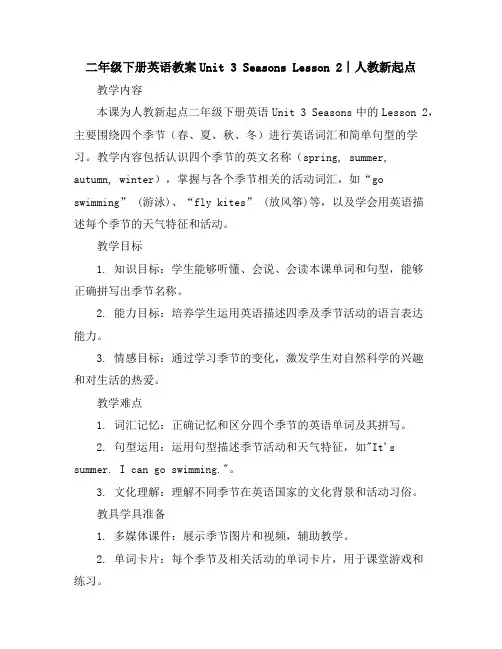
二年级下册英语教案Unit 3 Seasons Lesson 2∣人教新起点教学内容本课为人教新起点二年级下册英语Unit 3 Seasons中的Lesson 2,主要围绕四个季节(春、夏、秋、冬)进行英语词汇和简单句型的学习。
教学内容包括认识四个季节的英文名称(spring, summer, autumn, winter),掌握与各个季节相关的活动词汇,如“go swimming” (游泳)、“fly kites” (放风筝)等,以及学会用英语描述每个季节的天气特征和活动。
教学目标1. 知识目标:学生能够听懂、会说、会读本课单词和句型,能够正确拼写出季节名称。
2. 能力目标:培养学生运用英语描述四季及季节活动的语言表达能力。
3. 情感目标:通过学习季节的变化,激发学生对自然科学的兴趣和对生活的热爱。
教学难点1. 词汇记忆:正确记忆和区分四个季节的英语单词及其拼写。
2. 句型运用:运用句型描述季节活动和天气特征,如"It's summer. I can go swimming."。
3. 文化理解:理解不同季节在英语国家的文化背景和活动习俗。
教具学具准备1. 多媒体课件:展示季节图片和视频,辅助教学。
2. 单词卡片:每个季节及相关活动的单词卡片,用于课堂游戏和练习。
3. 季节活动道具:如风筝、游泳圈等模型,增加教学的直观性。
4. 学生练习册:用于学生课堂练习和课后作业。
教学过程1. 导入:通过播放季节变化的视频,吸引学生的注意力,引导学生谈论四季。
2. 新授:利用单词卡片和实物道具,教授四个季节的英文名称和相关的活动词汇。
3. 练习:进行听力、口语和书写练习,巩固新学词汇和句型。
4. 互动:分组讨论,让学生用英语分享他们最喜欢的季节和活动。
板书设计板书将分四个板块,每个板块对应一个季节。
每个板块将包含季节名称、天气特征、和相关活动的图片及英文表达。
例如,“Spring”板块将展示“flower”,“warm”和“fly kites”等。
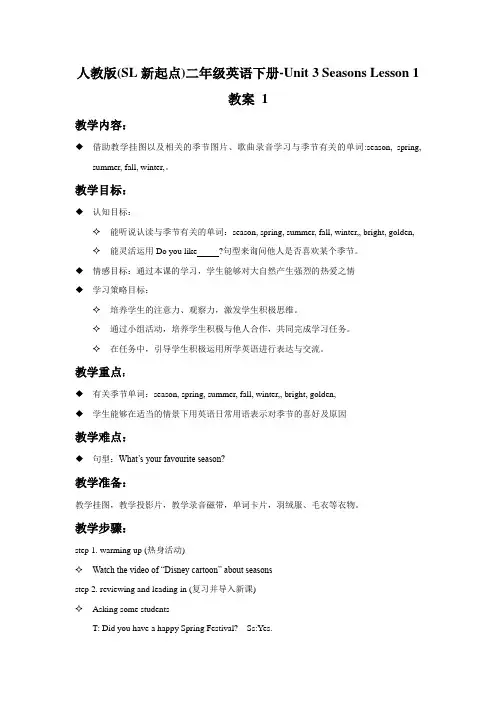
人教版(SL新起点)二年级英语下册-Unit 3 Seasons Lesson 1教案 1教学内容:◆借助教学挂图以及相关的季节图片、歌曲录音学习与季节有关的单词:season, spring,summer, fall, winter,。
教学目标:◆认知目标:✧能听说认读与季节有关的单词:season, spring, summer, fall, winter,, bright, golden,✧能灵活运用Do you like ?句型来询问他人是否喜欢某个季节。
◆情感目标:通过本课的学习,学生能够对大自然产生强烈的热爱之情◆学习策略目标:✧培养学生的注意力、观察力,激发学生积极思维。
✧通过小组活动,培养学生积极与他人合作,共同完成学习任务。
✧在任务中,引导学生积极运用所学英语进行表达与交流。
教学重点:◆有关季节单词:season, spring, summer, fall, winter,, bright, golden,◆学生能够在适当的情景下用英语日常用语表示对季节的喜好及原因教学难点:◆句型:What’s your favourite season?教学准备:教学挂图,教学投影片,教学录音磁带,单词卡片,羽绒服、毛衣等衣物。
教学步骤:step 1. warming up (热身活动)✧Watch the video of “Disney cartoon” about seasonsstep 2. reviewing and leading in (复习并导入新课)✧Asking some studentsT: Did you have a happy Spring Festival? Ss:Yes.T: But do you know what’s the meaning of spring? Let’s look at this picture. step 3. learning(学习新课)✧T: Now, let’s look at the picture. (教师出示挂图)T: What can you see in this picture?S1: I can see grass…...T: We can see trees, grass begin to turn green and flowers begin to come out.It’s spring.spring出示教学卡片,带领学生学习新单词1) read after the teacher 2)read in different waysLearn the expression : Spring is green.✧T: Spring is a season. There are four seasons in one year.season 出示教学卡片,带领学生学习新单词1) read after the teacher 2)read in different waysT: Do you like spring? Ss:Ss: Yes.T: Why?Ss: It’s green. I like green.✧T: Do you know any other season? S1: Summer.T: Look here.(出示夏天的教学卡片) What can you see?Ss: Bright sunshine.T: In this season, we can see many beautiful fl owers, bright sunshine. It’s summer.summer出示教学卡片,带领学生学习新单词1) read after the teacher 2)read in different waysLearn the expression : Summer is bright..✧T: Look at this picture.(出示秋天的教学卡片) What can you see?Ss: The leaves are yellow.T: In this season, the leaves begin to turn golden and fall. It’s fall.fall出示教学卡片,带领学生学习新单词1) read after the teacher 2)read in different waysLearn the expression : Fall is golden...✧T: Look at this picture.(出示冬天的教学卡片) What can you see?Ss:Snow.T: In thi s season, it snows sometime. It’s winter.winter出示教学卡片,带领学生学习新单词1) read after the teacher 2)read in different waysLearn the expression : Winter is white..✧Learn the song1 listen to the song ( twice)2 Follow the song3 Sing the song✧Learn the dialogue1 listen to the dialogue ( twice)2 Follow the dialogue3 Read the dialogue4 Ask 2 students to read the dialoguestep 4. practicing (操练)✧T: Do you like ? (spring /summer/fall/winter)S1: Yes.T: Why?S1: It’s .(形容词)✧Pair work✧Show some pairs’ jobsstep 5. summary (小结)✧今天学习了有关季节的词汇:season, spring, summer, fall, winter,, bright, golden,✧学习了常用的有关季节的交际用语:Do you like ? Why? 并能运用所学知识进行回答。
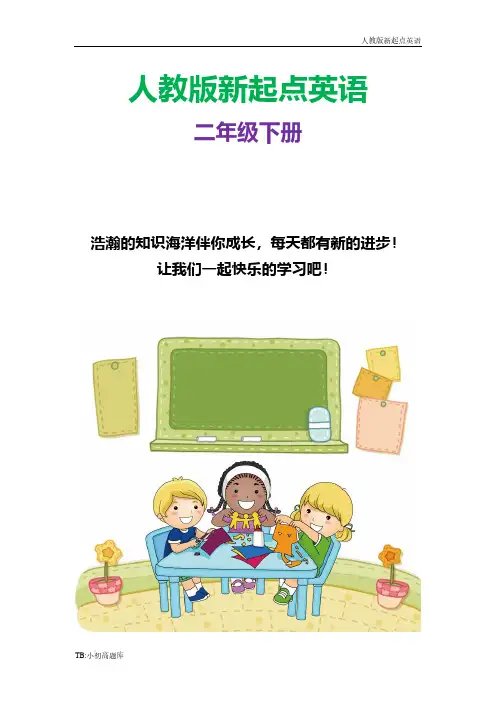
人教版新起点英语二年级下册浩瀚的知识海洋伴你成长,每天都有新的进步!让我们一起快乐的学习吧!Unit 3 SeasonsLesson 3教学设计3一、教材分析主要是学习运用spring, summer, fall and winter四个季节名词和plant trees, swim, climb the hills and make a snowman等动词短语以及We can climb hills in fall.等句型。
体现语言的交际功能。
二、教学目标知识目标:1.记忆和运用单词:spring, summer, fall, winter, plant, swim, climb and snowman2.运用句型:It’s spring.We can make a snowman in winter.What’s your favorite season?I can fly a kite in spring.能力目标:1.根据教学内容和借助多媒体课件来培养学生的听说能力。
2.通过自主说,两两对话和小组活动等形式,培养和提高学生的口语交际能力和运用英语的能力。
情感目标:在学生两两交流和小组合作交流中,培养孩子合作学习的意识,激发学生学习兴趣,实现“趣能”两得。
三、教学策略歌谣激趣,营造英语学习的氛围,师生对话,两俩对话,小组合作等形式。
四、教学资源1,本课教材。
2,拓展资源:跨越式英语教学课题组资源。
五、教学媒体多媒体,flash动画和录音机。
六、教学过程1.课前齐唱所学的英文歌曲<<the seasons>>营造英语学习的氛围。
2.师生问候。
3.Free talk。
教师根据自己的图片进行自由谈论有关季节的话题。
使学生在今后的学习中效仿。
Key words:I have a picture. It is very beautiful. It is spring. The trees turn green and the grass is green, too. I like spring very much because spring is green and beautiful.让同学们根据自己的图画来谈论自己所喜欢的季节。
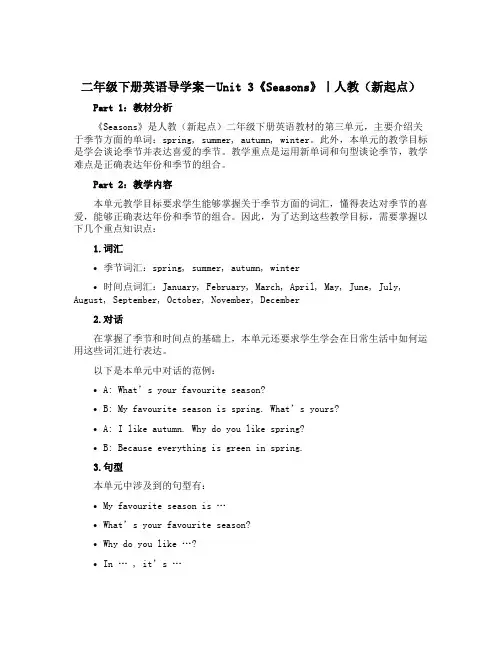
二年级下册英语导学案-Unit 3《Seasons》|人教(新起点)Part 1:教材分析《Seasons》是人教(新起点)二年级下册英语教材的第三单元,主要介绍关于季节方面的单词:spring, summer, autumn, winter。
此外,本单元的教学目标是学会谈论季节并表达喜爱的季节。
教学重点是运用新单词和句型谈论季节,教学难点是正确表达年份和季节的组合。
Part 2:教学内容本单元教学目标要求学生能够掌握关于季节方面的词汇,懂得表达对季节的喜爱,能够正确表达年份和季节的组合。
因此,为了达到这些教学目标,需要掌握以下几个重点知识点:1.词汇•季节词汇:spring, summer, autumn, winter•时间点词汇:January, February, March, April, May, June, July, August, September, October, November, December2.对话在掌握了季节和时间点的基础上,本单元还要求学生学会在日常生活中如何运用这些词汇进行表达。
以下是本单元中对话的范例:•A: What’s your favourite season?•B: My favourite season is spring. What’s yours?•A: I like autumn. Why do you like spring?•B: Because everything is green in spring.3.句型本单元中涉及到的句型有:•My favourite season is …•What’s your favourite season?•Why do you like …?•In … , it’s …学生需要在学习这些句型的同时,掌握它们在实际使用中的时态和变化形式,以确保表达的准确性和自然性。
Part 3:教学方法在授课过程中,教师需要采用适当的教学方法来确保学生在学习过程中的参与度和学习效果。
二年级下册英语教案 Unit 3 Seasons Lesson 4 人教(新起点)教学内容本课为《人教(新起点)二年级下册英语》Unit 3 Seasons的第四课时。
学生将学习四个季节的英文表达,包括spring, summer, autumn, winter。
通过本课的学习,学生能够描述和比较不同季节的特点和活动,如春天的花朵、夏天的阳光、秋天的落叶和冬天的雪。
教学目标1. 知识与技能:学生能够正确认读并运用四个季节的英文单词,并能用简单的句子描述每个季节的特点。
2. 过程与方法:通过图片展示、游戏互动和小组讨论,学生将提高英语听说能力和团队合作能力。
3. 情感态度价值观:培养学生对自然环境的热爱和对不同季节活动的兴趣。
教学难点1. 正确发音和记忆四个季节的英文单词。
2. 运用句型描述季节特点和活动。
教具学具准备1. 四季图片卡片。
2. 季节相关的活动图片。
3. 黑板和粉笔。
4. 录音机及教学音频。
教学过程一、导入1. 复习旧知:通过快速问答复习上一课时的内容,激活学生已有知识。
2. 引入新课:展示不同季节的图片,引导学生猜测和讨论。
二、新课内容展示1. 展示单词:使用季节图片卡片,教授spring, summer, autumn, winter四个单词。
2. 句型练习:利用句型"It's in season."进行替换练习,让学生描述每个季节的特点。
三、互动活动1. 听力练习:播放录音,学生听季节相关的句子,并选择对应的图片。
2. 小组合作:学生分小组,每组选择一个季节,讨论并准备介绍该季节的活动和特点。
四、输出展示1. 小组报告:每组派代表向全班介绍他们选择的季节。
2. 学生展示:鼓励学生用新学的单词和句型进行个人展示。
2. 作业布置:要求学生绘制自己最喜欢的季节,并用英文简单描述。
板书设计板书将简洁明了地展示本课的关键内容,包括四个季节的英文单词和关键句型。
二年级下册英语说课稿-Unit 3 Seasons 第二课时人教新起点前言本次英语课程是针对二年级下册的 Unit 3 Seasons 的第二课时进行的教学。
通过本节课的教学,旨在帮助学生掌握四季的英文及描述各季节的特点。
在此之前,学生应该已经学习过四季的英文单词和基础句型,本节课从听、说、读、写四个方面对学生的英语水平进行全面提升。
教材分析教材内容本节课的教材内容是对四季的介绍,具体内容如下:1.Spring: It’s warm. The flowers are beautiful.2.Summer: It’s hot. I like swimming.3.Autumn: It’s cool. The trees are yellow.4.Winter: It’s cold. I like skiing.通过对教材内容的分析,我发现学生对季节的感性认识已经比较明显。
通过教师引导和丰富的课堂活动,可以帮助学生对四季的认知更加深入,同时实现对英语学习的更好掌握。
教学目标通过本节课的教学,学生应该达到以下目标:1.熟练掌握四季的英文单词及句型;2.了解各季节的特点,并对其进行简单描述;3.培养学生的口语表达能力,提高其听、说、读、写的综合水平。
教学过程导入新课1.教师采用图片或多媒体设备展示四季的图片,让学生进行观察和描述。
2.引入本节课的教材 Unit 3 Seasons,让学生重温已经学习过的季节单词及句型。
主体部分1.听力训练:听取教师念出四季的描述语句子,让学生选择正确的季节图片。
2.口语表达:学生进行模仿、朗读和仿写四季的特点表达,鼓励学生进行个性化的描述,按照自己的语言习惯和感知,在口语表达中充分发挥自己的想象和创造力。
3.阅读理解:教师让学生阅读课本中每个季节的图片、文字和简单句子,并做简单的阅读理解练习。
4.作文练习:教师让学生根据自己喜爱的季节进行简单的作文练习,鼓励学生在练习中体验英语学习的快乐。
人教版新起点英语二年级下册《Unit3Seasons Lesson2》教案一、教学目的1.通过本课的学习,让学生掌握四季的名称和特点;2.培养学生注意力和听力,并提高学生的英语口语表达能力;3.增加学生的英语词汇量和语言运用能力。
二、教学重点1.掌握四季的名称;2.学会用简单的英文句子表述四季的特点。
三、教学难点1.学生对于季节的认识和表述;2.学生的英语口语表达水平。
四、教学方法1.听力操练;2.小组讨论;3.教师指导。
五、教学过程1. 自我介绍(5分钟)首先,教师介绍自己,并向学生们问好。
然后,教师通过一个游戏来回忆上节课所学的内容,巩固学生们的记忆。
2. 导入新课(10分钟)1.教师带领学生观察四幅图片,分别是夏季、秋季、冬季和春季的场景;2.通过对图片的解释,让学生们能够初步了解四季的名称和特点;3.学生跟读教师的发音,模仿表述四季的特点。
3. 听力训练(15分钟)1.教师播放一段录音,录音中包含了有关四季的基本介绍;2.分组讨论,学生们互相交流、分享所听到的信息,并补充自己的认识。
4. 练习表述四季的特点(20分钟)1.将学生分成小组,每组由2-3人组成;2.要求每个小组表述一种季节的特点;3.每个小组展示表述的结果,教师进行点评和纠正。
5. 小结(10分钟)1.对本节课所学习的内容进行复习;2.每个学生说出一个季节的名称,并表述出该季节的特点;3.让学生总结学习本节课的心得和收获。
六、课后作业1.背诵本节课所学习的四季名称和其特点;2.和家长一起观察当季的天气,并说出天气特点,如:“今天是晴天,太阳很大,`,温度有点高。
”七、板书设计本节课的板书内容如下:四季名称:summer, autumn, winter, spring.例如:•summer: hot, sunny, long days, short nights;•autumn: cool, dry, colourful, leaves fall;•winter: cold, snowy, short days, long nights;•spring: warm, rny, flowers bloom.八、教学反思本节课中,教师以图片、录音、小组讨论等方式,激发了学生的学习兴趣,提高了他们的听力及口语表达能力。
Unit 3 Seasons单元教材分析:本单元主要学习有关季节及其气温特点的八个词汇:sping.summer.autumn.winter.hot,warm,cool,cold.本单元的活动用语What’s your favourite season? Sping\Summer\Autumn\Winter.It`swarm\hot\cool\cold.并能初步在恰当的情景中运用。
本单元是学生开学后的第三单元,与学生生活实际紧密联系,学习有关季节及其气温特点的用语,易于学生接受,内容简单实用,易懂。
单元教学目标:1.能够在本单元涉及的情景条件下说出与季节有关的8个单词。
2.能够在本单元涉及的情景条件下初步使用本单元所学的句型。
3.能够在本单元涉及的情景条件下用英语日常用语表示对季节的喜好。
4.能够听懂常用的表示对季节的喜好的英语日常用语并做出相应的反应。
5.通过歌曲和游戏学会用英语表达对不同季节的喜好及其原因。
6.能够观察到四季的不同并且用所学语言予以表达。
7.能够初步了解字母组成单词的过程。
单元教学重点:1.能够在本单元涉及的情景条件下听懂并说出与季节有关的8个单词。
2.能够在本单元涉及的情景条件下初步使用本单元所学的句型:What’s your favourite season?单元教学难点:能够在本单元涉及的情景条件下初步使用本单元所学的句型:What’s yourfavourite season?单元课时安排:五课时第一课时教学内容:A Look, listen and chant教学目标:能够在适当的情景下听懂,说出与季节有关的4个单词和表示气温特点的4个单词。
教学重点:学会读与季节有关的4个单词。
教学难点:表示气温特点的4个单词。
教学准备:光盘,卡片教学时间:月日教学过程:一.热身(Warm-up)1.师生问好。
2.跟随录音大胆说唱第二单元的歌谣。
二.预习(Preview)Asking some studentsT: Did you have a happy Spring Festival? Ss:Yes.T: But do you know what’s the meaning of spring? Let’s look at this picture.三.新课呈现(Presentation)T: Now, let’s look at the picture. (教师出示挂图)T: What can you see in this picture?S1: I can see grass…...T: We can see trees, grass begin to turn green and flowers begin to come out.It’s spring. spring出示教学卡片,带领学生学习新单词。
二年级下册英语说课稿-Unit 3 Seasons 第三课时人教新起点一、教学目标1. 知识目标1.学生能够掌握四季的基本英语词汇(spring, summer, autumn, winter)。
2.学生能够听、说、读、写有关四季的英语句子。
2. 能力目标1.学生能够通过图片、动作、实物等多种形式表达自己的四季经验,培养交际能力和表达能力。
2.学生能够理解和应用一些简单的英语口语固定句式,如“What’s your favourite season? My favourite season is…”。
3. 情感目标1.通过学习四季的英语表达和图片,激发学生对自然界的热爱和兴趣。
2.让学生学会关注自然环境,学会养成良好的环保意识。
二、教学重点和难点1. 教学重点1.学生掌握四季的英语词汇,并能够应用到日常生活中。
2.学生掌握“What’s your favourite season? My favourite season is…”的口语表达。
2. 教学难点1.教师如何通过图片和动作等多种方式让学生理解和掌握四季的英语表达。
2.教师如何引导学生运用学到的英语句子表达自己对四季的感受。
三、教学过程1. 导入1.教师播放一段四季的视频,介绍四季的基本概念和特点,并引导学生用自己的语言表达对四季的感受。
2.教师借助图片和实物等展示四季的特点和景象,让学生更加深入地了解四季的不同之处。
2. 学习1.教师通过书本上的图片,向学生介绍四季的英语表达,并让学生读出和记住这些单词。
2.教师向学生展示有关四季的英语句子,并引导学生模仿课文朗读,以培养学生的语感和口语表达能力。
3.教师让学生通过动作和实物等方式表达自己对四季的喜爱,并引导学生使用“What’s your favourite season? My favourite season is…”表达自己的观点。
3. 练习1.教师让学生进行合作活动,以巩固所学的英语表达和句子,例如两名学生进行角色扮演,问对方喜欢哪个季节,并根据对方的回答进行回应。
. Unit3 第3课时教学设计 【内容来源】人民教育出版社(一起点)二年级下册 Unit3 【主 题】Seasons 【课 时】第3课时 一、教学目标(Teaching aims) 1. 初步学会在恰当的情境下运用本单元以及前面单元所学的词汇和功能句。 2. 按照正确笔顺书写字母Li, Jj, Kk, Ll,字迹清晰即可;复习上述字母在词首的常见发音,并尝试拼读单词,然后把其所缺字母补充完整;尝试在图片和首、尾字母的帮助下整体识别单词。 二、各板块教学建议 A. Let s play. 1. 复习 (1) “Sorting game”游戏:教师说cloudy, sunny,学生结对比赛往下接,看谁说的同类词多。 Tip:游戏内容可涉及天气词汇、活动、词组、季节和服装等词汇,这可为A项活动及拓展活动做准备。 (2) 教师带领学生复习第一课时的歌谣。 (3) 通过师生小访谈,帮助学生复习本单元词汇和功能句:What’s your favourite season? What’s the weather like?之后,学生结对完成访谈活动。 2. 游戏 (1) 教师出示A项情境图,并提问学生:Who are they? What are they doing? How can they play the game? (2) 让学生听对话录音,关注录音中人物的语言,了解游戏方式。 (3) 教师准备好卡片,然后请一名学生上讲台前与教师一起再次进行示范,以帮助学生再次了解游戏语言和过程。 (4) 学生结对展开游戏。 (5) 男女生比赛:请一名学生上讲台前,其他学生集体向他/她提问:What’s your favourite season? What’s the weather like?站在讲台前回答问题的学生和最快. 猜到答案的学生均可以按男女生分组加分。 B. Let’s write. 1. 复习字母 (1) 教师快速闪现字母卡片,帮助学生复习字母。 (2) 教师组织学生开展“大小写字母找朋友”的活动。 Tip:教师呈现两组四线三格的手写字母卡,一组为大写字母,一组为小写字母,请学生迅速匹配。该活动的目的是帮助学生复习已经学过的字母的书写。卡片中也可包含Li, Jj, Kk, Ll,这样就可直接过渡到新字母的书写教学。 2. 学习书写字母 (1) 学生观察字母的占格。 (2) 学生观察字母的笔顺。 (3) 学生观察教师书写,进行书空。 (4) 学生书写字母。 3. 书写单词中的字母 (1) 一名学生根据B项提供的图片尝试拼读单词。 (2) 请这名学生的同伴根据该学生的读音尝试书写单词中的字母。 4. 听人名,补充字母 教师可说如下一些人名:Ivy, Jane, Kate, Lucy,请学生把缺了字母的人名补充完整。 Tip:下划线的字母为空缺的字母。教师说人名,请学生判断应该填写哪个大写字母;如果班里有叫这个名字的学生,则该学生可以起立,继续问问谁的名字以这些字母开头。这样会使枯燥的字母学习更具趣味性。 备选活动 1. 师生示范,拓展对话内容,如: S: What’s your favourite season? T: Winter. It’s cold and white. I can make a snowman. I can wear my red sweater in winter. 2. 学生结对,尝试创编对话。 3. 学生展示所编对话。 . 【板书设计】 【教学反思】
Unit 3 Seasons 单元教材分析: 本单元主要学习有关季节及其气温特点的八个词汇: sping.summer .autumn .winter.hot,warm,cool,cold.本单元的活动用语What’s your favourite season? Sping\Summer\Autumn\Winter.It`s warm\hot\cool\cold.并能初步在恰当的情景中运用。本单元是学生开学后的第三单元,与学生生活实际紧密联系,学习有关季节及其气温特点的用语,易于学生接受,内容简单实用,易懂。 单元教学目标: 1.能够在本单元涉及的情景条件下说出与季节有关的8个单词。 2.能够在本单元涉及的情景条件下初步使用本单元所学的句型。 3.能够在本单元涉及的情景条件下用英语日常用语表示对季节的喜好。 4.能够听懂常用的表示对季节的喜好的英语日常用语并做出相应的反应。 5.通过歌曲和游戏学会用英语表达对不同季节的喜好及其原因。 6.能够观察到四季的不同并且用所学语言予以表达。 7.能够初步了解字母组成单词的过程。 单元教学重点: 1.能够在本单元涉及的情景条件下听懂并说出与季节有关的8个单词。 2.能够在本单元涉及的情景条件下初步使用本单元所学的句型: What’s your favourite season? 单元教学难点: 能够在本单元涉及的情景条件下初步使用本单元所学的句型:What’s your favourite season? 单元课时安排:五课时
第一课时
教学内容: A Look, listen and chant 教学目标: 能够在适当的情景下听懂,说出与季节有关的4个单词和表示气温特点的4个单词。 教学重点: 学会读与季节有关的4个单词。 教学难点: 表示气温特点的4个单词。 教学准备:光盘,卡片 教学时间: 月 日 教学过程: 一.热身(Warm-up) 1.师生问好。 2.跟随录音大胆说唱第二单元的歌谣。 二.预习(Preview) Asking some students T: Did you have a happy Spring Festival? Ss:Yes. T: But do you know what’s the meaning of spring? Let’s look at this picture. 三.新课呈现(Presentation) T: Now, let’s look at the picture. (教师出示挂图) T: What can you see in this picture? S1: I can see grass„... T: We can see trees, grass begin to turn green and flowers begin to come out.It’s spring. spring出示教学卡片,带领学生学习新单词。 1) read after the teacher 2) read in different ways Learn the expression : Spring is green. T: Spring is a season. There are four seasons in one year.season 出示教学卡片,带领学生学习新单词。 1) read after the teacher 2)read in different ways T: Do you like spring? Ss: Yes. T: Why? Ss: It’s green. I like green. T: Do you know any other season? S1: Summer. T: Look here.(出示夏天的教学卡片) What can you see? Ss: Bright sunshine. T: In this season, we can see many beautiful flowers, bright sunshine. It’s summer. summer出示教学卡片,带领学生学习新单词。 1) read after the teacher 2)read in different ways Learn the expression : Summer is bright.. T: Look at this picture.(出示秋天的教学卡片) What can you see? Ss: The leaves are yellow. T: In this season, the leaves begin to turn golden and fall. It’s fall. fall出示教学卡片,带领学生学习新单词。 1) read after the teacher 2)read in different ways Learn the expression : Fall is golden... T: Look at this picture.(出示冬天的教学卡片) What can you see? Ss:Snow. T: In this season, it snows sometime. It’s winter.winter出示教学卡片,带领学生学习新单词。 1) read after the teacher 2)read in different ways Learn the expression : Winter is white.. 四.巩固和延伸(Consolidation and extension) Learn the song: 1)listen to the song ( twice) 2) Follow the song 3)Sing the song 附:板书设计: Lesson 1 spring summer fall winter
教学后记:
第二课时 教学内容: B Look and say 教学目标: 1.能够通过看图识别四个不同的季节:spring summer fall winter 2.能够在一定情景下使用I\We can„的句型来表达与四季有关的活动 3.通过本课的学习,学生能够对大自然产生强烈的热爱之情 教学重点: 学会运用句型:What’s the weather like in autumn? 教学难点: 重点句的答句It’s warm and windy . 教学准备:光盘,卡片 教学时间: 月 日 教学过程: 教学过程: 一.热身(Warm-up) 1.师生问好。 2.跟随录音大胆说唱第二单元的歌谣。 二.预习(Preview) 1) Read the words together 2) Read the flash words (单词闪现) 3) Guessing game Review the expressions T: Do you like ? Ss: Yes. T: Why? Ss: It’s . 三.新课呈现(Presentation) 整体呈现(挂图—听录音,同时指导学生看图,让学生反复听录音) 1)T: What season is it? S: Spring. T: Yes, it’s spring. In spring, we can plant trees, fly kites. Plant trees( 通过动作.简笔画教授此动词词组然后听录音) 2)T: What season is it? S: Summer. T: Yes, it’s summer. In summer, we can swim, eat ice cream. Swim( 通过动作.简笔画教授此动词词组然后听录音) 3)T: What season is it? S: Fall. T: Yes, it’s fall. In fall, we can climb hills, pick apples. climb hills ( 通过动作.简笔画教授此动词词组然后听录音) 4)T: What season is it? S: Winter. T: Yes, it’s winter. In winter , we can make a snowman, go skating. make a snowman ( 通过动作.简笔画教授此动词词组然后听录音) 如果时间充裕,可以适当拓展一些其他的动词词组。 四、 巩固和延伸(Consolidation and extension) 1、 Example ——Group work ——show eg: T: What season do you like? S1: T: Why? S1: (强化We can do„句型) 2.Learn the chant 1) Listen to the chant 2) Follow the tape 3) Sing the chant 3.Gussing game 1)教师在上课前根据本课内容准备8张小图片,分别画者所学的8个动作的简笔画(放风筝,游泳,摘苹果,滑冰,种树,吃冰淇淋,爬山,堆雪人),并附有英文句, 如:It’s summer! It’s summer! We can swim in summer.